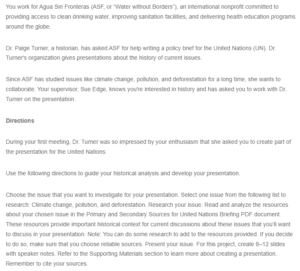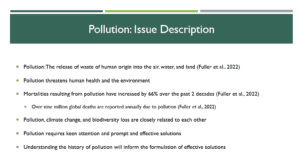Environmental Science Shaping Current Circumstances
ORDER A PLAGIARISM-FREE PAPER HERE
We’ll write everything from scratch
Question
You work for Agua Sin Fronteras (ASF, or “Water without Borders”), an international nonprofit committed to providing access to clean drinking water, improving sanitation facilities, and delivering health education programs around the globe.

Environmental Science Shaping Current Circumstances
Dr. Paige Turner, a historian, has asked ASF for help writing a policy brief for the United Nations (UN). Dr. Turner’s organization gives presentations about the history of current issues.
Since ASF has studied issues like climate change, pollution, and deforestation for a long time, she wants to collaborate. Your supervisor, Sue Edge, knows you’re interested in history and has asked you to work with Dr. Turner on the presentation.
Directions
During your first meeting, Dr. Turner was so impressed by your enthusiasm that she asked you to create part of the presentation for the United Nations.
Use the following directions to guide your historical analysis and develop your presentation.
Choose the issue that you want to investigate for your presentation. Select one issue from the following list to research: Climate change, pollution, and deforestation. Research your issue. Read and analyze the resources about your chosen issue in the Primary and Secondary Sources for United Nations Briefing PDF document. These resources provide important historical context for current discussions about these issues that you’ll want to discuss in your presentation. Note: You can do some research to add to the resources provided. If you decide to do so, make sure that you choose reliable sources. Present your issue. For this project, create 8–12 slides with speaker notes. Refer to the Supporting Materials section to learn more about creating a presentation. Remember to cite your sources.
In your presentation, Dr. Turner asked you to describe your chosen issue. Describe your research approach. How did you analyze primary and secondary sources on the issue? What questions did you ask about the documents? How did you identify the facts to make your point? What did you learn from the documents about the history of your issue? Analyze your issue. What is the history of the issue? Describe the issue based on your analysis of the primary and secondary sources that you researched. How have historians described and interpreted this issue in the past? How has this changed over time? (Note: Be sure to discuss multiple perspectives and focus on how these perspectives changed over time.) How did various groups present the issue throughout history (including social, economic, and political interests)? Have these presentations changed or remained the same over time? Relate your issue to the present. How does the history of your issue relate to current circumstances? What are the similarities and differences between past and present? Explain how history informs current discussions about the topic. How could historical context and inquiry inform current discussion and future decisions about your issue? Historical context refers to the norms and values of a particular time in history. For example, consider the current issue of expanding voting rights for prisoners in the United States. When analyzing this issue, it’s important to consider the historical context of voting rights in this country. In 1865, the 15th Amendment to the Constitution gave African American men the right to vote. In 1920, women were given the right to vote by the 19th Amendment. Understanding this context can help inform your discussion of the issue.













